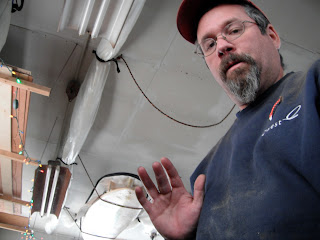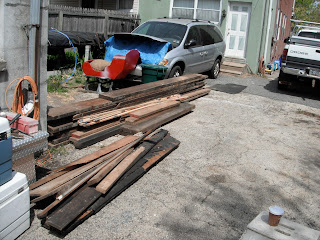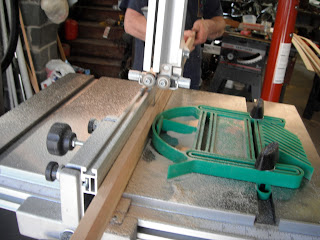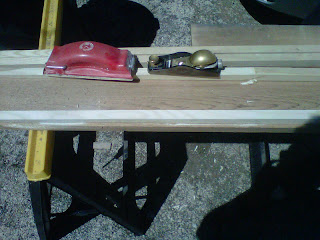*Yelling in my Ringo voice* "I've got splinters on me fingers!"
This weeks project amoung others including de-termiting the canoe rack area and braving the Nor'Easter in the middle of the night to keep the shop roof from collapsing was getting that free wood closely inspected and milled into planks and strips for future projects. One project being a stand up paddleboard that I aptly named today, "the Piney" as I want to use this pine for it. I'm thinking, now that we started milling it that the very resinous nature of the wood and it's weight may prove it to be a bad choice for a medium that needs to be laminated with epoxy and fiberglass as it may not adhere. I was going to research this a bit before I started today's blog, but I stopped at my brother's place and Whale Wars was on, so I opted to watch and see what Capt. Paul Watson was up to.
But now I need to keep the blog up to date with some pics and info as it has been a while since my last scribblings.
I'm choosing the centered paragraph format as my pics are centered and it just feels better to me. Alas, Dogfish Head Brewery may prefer my blog to be off-centered, but I'm thinking that the content is more important to be off-centered than the presentation.
I think I'm killing my Uncle and my Dad with this free lumber. If I'm not sending one of them off to the hospital, I am wearing them out by the end of the day so much that are about to keel (nautical speak) over! These planks were too much for us. They were way too big and in way too bad of condition. They needed way too much milling on my machines that are hobby machines at best. These planks require heavy equipement and three people to handle them. They are laiden with so much resin that it makes them heavy and sticky. My machines are getting gummed up. I'm also realizing that even though these rafters are probably over 100 years old, they still have moisture in them!
So, basically, we are going to mill the rest of them, pick out all the best pieces and stash them inside somewhere hopefully out of the way and see if they dry out some while I research laminating them with epoxy. This may have been a waste of time in terms of materials, but in the realm of education it was golden.
Also, I'm going to be soliciting the aid of some volunteers once again. Shannon is going to be helping with the canoe and surfboards and I may try and get Robin to come back and help as well. We have two months to finish the canoe, finish the redwood log, and maybe get to the SUP as well before the Mystic Show in Connecticut. I'm just going to focus on the projects at hand first, I still have the yard to plant, the roof to completely remove (even the rafters need to be sistered as they have rotted) and a lean-to car park to build for the canoes, lumber and Keith's boat.
I love a challenge!
Setting the ambiance with:
{ River Horse Lager & The Gourds "Gin and Juice"}
Unfortunately a goodly portion of this wood has to be burnt as I have nowhere to place wood that is infested with termites. It makes for a pretty fireplace scene though!
Feed me Seymore!
Above is the feeder of the plane.
We tried splitting a plank before the surfaces were cleaned up any. The planks proved to be wicked rough and caught every surface they touched on the saw, etc... so we decided to plane them lightly to take off the roughness.
My Uncle got pooped and split so my dad took over for him. My uncle Rich is looking way better and is healing great! This wood will be the death of us all! Above is my father tugging on this plank. There was a painted 4X4 in the mix and it turned out to have this really nice grain with an awesome red color to it. It was probably the best piece of wood out of the whole lot. Really beautiful. I do get a kick out of recycling as much of this stuff that most likely would have ended up in a landfill or a furnace somewhere, so we are doing our part for Mother Nature, maybe? It's tough to say after all the electricity and fossil fuels used to save it. Would it have been better off rotting on the forest floor? Perhaps.
HA! The above picture turned out better than I thought it would! There is our bitty saw with the vacuum hooked up to it. I'm glad we did that because it was getting jammed up with dust. The saw proved too light weight and top heavy. LOL Which is it? Light or heavy?
{Dang! This is a pretty good lager from River Horse! Crisp, light and refreshing. The Gourds album is pretty mellow as well, jammin mandolin}
Most of the planks we did today were of the better quality ones as we tried to get them done before the rains return tomorrow. I would have liked to finish this before any more moisture fell, but we need the rain, we will find a way. There is always another way. I saved the super resinous ones for last. They are actually the clearest of them all with absolutely no knots, but gummy. The rain might not even effect them!
{Linton Kewesi Johnson "Dread Beat and Blood}
Ciao!


























































